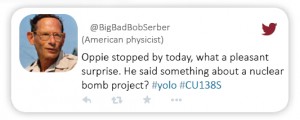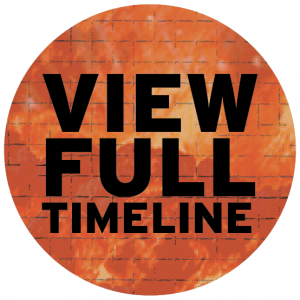BY REBECCA COSTELLO

![Atomic_D[2]](http://news.colgate.edu/scene/wp-content/uploads/sites/2/2014/07/Atomic_D2-300x197.jpg) sually, professors cringe when students glance at their smartphones in class. But Karen Harpp has used the devices to transform how her students learn.
sually, professors cringe when students glance at their smartphones in class. But Karen Harpp has used the devices to transform how her students learn.This spring, Harpp had her students write a “Twitter play” in her course The Advent of the Atomic Bomb (Core 138S). Each student had to research and take on the persona of a major historical figure in the atomic bomb story — including scientists, military leaders, and journalists. Then, over five weeks, they had to respond via tweet to the events playing out from Pearl Harbor to Japan’s surrender, through the voice of their characters.
Harpp shared how she transformed her course using the edX platform at the Innovation + Disruption symposium on May 5. Sponsored by Colgate, the gathering of leaders in higher education discussed the risks and rewards of innovation in the digital age at New York City’s TimesCenter (you can read more in the President’s Message).
Knowing that young adults benefit from the perspectives of others, Harpp has invited alumni into the course for more than 10 years.
Alumni, she said, “pushed the students to question their preconceived notions. They asked questions the students never would, and brought in perspectives from the military, government, economics, business, and environmental fields.”
More than 350 alumni, from recent graduates to World War II veterans, joined in on this latest iteration — which Harpp and the organizers fondly dubbed a SPOC (selective private online course). It included course lectures on video, a discussion board, and videoconferences. The students and alumni also collaborated to create an in-depth interactive online timeline.
 “We grapple with really complicated questions,” Harpp said of the course, which delves into the scientific, technical, historical, and social perspectives on the story of the atomic age. “Why were the bombs dropped in the first place? What were the immediate physical and political effects, and what are their long-term geopolitical effects?”
“We grapple with really complicated questions,” Harpp said of the course, which delves into the scientific, technical, historical, and social perspectives on the story of the atomic age. “Why were the bombs dropped in the first place? What were the immediate physical and political effects, and what are their long-term geopolitical effects?”
It seems fitting, yet perhaps ironic, that the first course at Colgate to experiment with technology that is disrupting higher education would be about technology that was, arguably, the biggest disruptor of the last century.
But the results, said Harpp, associate professor of geology, were remarkable. “The students would invoke their characters spontaneously in class discussions. I’ve never seen such a level of engagement with the atomic bomb story.”
Here is a taste of how the class’s telling of the story of the atomic age unfolded.
Innovation + Disruption symposium
[youtube http://www.youtube.com/watch?v=I5dq8Y8-wyY]



There is a disturbing error in the Timeline segment of “The Advent of the Atomic Bomb.” The timeline states that Eisenhower made the “Atoms for Peace” speech in 1972. Eisenhower died in 1969. He actually made that speech in 1953.
Dear Harry,
Thank you for reading the Scene and for pointing out the error on the timeline. We have made the correction.
Best wishes,
Rebecca Costello
Managing Editor